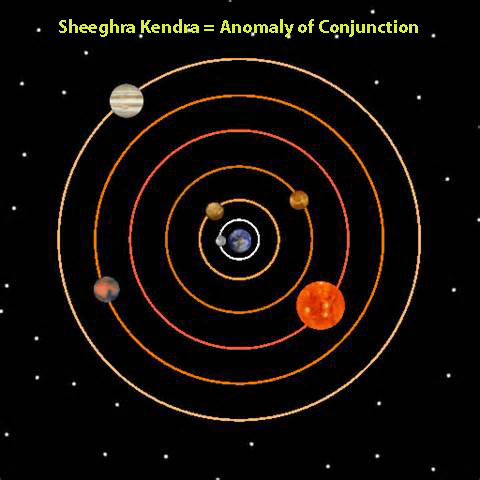Revealed to the Indian
Seers in yogic flashes of heightened Consciousness,
Hindu Astrology was developed
strictly on scientific laws. Backed up by Astronomy and Maths, Astrology
continues to rule as the Queen & Mother of all Sciences.

Long Astro Cycles have fascinated mankind. This is the
Hindu perspective of Astro Cycles.
The Vernal Equinoctial Point was
found to precede one degree in every 72
years. Hence as one Zodiacal Sign is
30 degrees in length, 2160 years is
the duration of an Age Cycle. We are at
the moment undergoing the Piscean Age which will give way to the Aquarian in
2444 AD. It is called
the Piscean Age because the Vernal Equinoctial Point is
passing through
Pisces and is at the moment 06 degrees 40 minutes 24 seconds
in Pisces.
Age
Cycle
(
72*30)
= 2160
years
Precessional Cycle
(72*360)
= 25920 years
( as the Zodiac is 360 degrees )
Equinoctial
Cycle
(2000*2160)
=
43,20000 years
Cosmological Cycle
( 2 million *
2160 )
=
4.32 billion years
One Cycle of Brahma = 100 Brahma years
One Day of Brahma = 4.32 billion years
Hence one Super Cosmological Cycle or
Maha Manvantara = 4.32*2*365.25*100 = 311.04 trillion years
One Cosmological Cycle ( Brahma Kalpa) was considered
to be one
Brahma Day and another 4.32 billion years was considered to
be
one Brahma Night. One Cosmological Cycle was one thousand
Equinoctial
Cycles ( Chatur Yugas) or 2 million Age Cycles!

The Hindu Calendar -
Based on Equinoctial Cycles
An Equinoctial Cycle comprises of 4
Ages.
Satya
Yuga
Threta
Yuga
= 600 Age
Cycles
Dwapara Yuga
= 400 Age
Cycles
Kali
Yuga
= 200 Age
Cycles
______________________________
Maha
Yuga
= 2000
Age Cycles
( Equinoctial Cycle )
As per Hinduc Astronomy, the Dark Age
( Kali Yuga ) commenced from 3102 BC , 16th February Midnight.
The
Concept of Ayanamsa
The Date of Coincidence of the Tropical and the
Sidereal Zodiacs was found to be 285 AD and the Ayanamsa ( precessional
distance ) was called Lahiri's Ayanamsa. Different scholars gave different
dates but the Indian Govt in order to standardise the Ayanamsa value took the
initial point of the Zodiac as the point in the Ecliptic opposite the star
Chitra ( Alpha
Virginis ) which was the vernal equinoctial point on the
Vernal Equinox day of 285 AD. The rate of precession of the Vernal Equinox
was taken as 50.3 seconds per sidereal year.
In Hindu Astrology,
Ayanamsa value is deducted from the Tropical longitudes of planets to get the
Sidereal longitudes. Hence the longitudes of planetsin Western Astrology (
Tropical ) and Indian Astrology differ by 23.5 degrees this year. Natal
charts cast in these 2 systems will be entirely
different!
The
Tropicalists ( Western Astrologers) maintain that the Vernal Point is in the
6th degree of Pisces now . The Siderealists ( Hindu Astrologers )
maintain
that the Sidereal Starting Point remains to be 0 degrees Beta
Arietis (
Aswini ) and that the Sidereal Zodiac doesn't change.

Scientific Offshoots of Astrology
Pythagorus
discovered that the Nine numbers correspond to the Nine
revolving heavens and
became the founder of Astro-Numerology. The
most auspicious number Three was
represented by the monarch of
the sky, Jupiter.
Another intuitively scientific offshoot of Astrology
was
Gemology. The nine gems correspond to the nine planets and Gems
were found to heal humans.This gave birth to the science of Gem Therapy.
|
|
Astrology as related to Yoga
As per Indian
Philosophy, Astrology was considered to be the foremost
amonst the six
auxiliary sciences as Yoga was considered to be the
foremost amongst the six
main sciences. Even Yogis used to consult
astrologers about gaining
Self-Actualisation. Jupiter, Saturn and the
South Node were considered to be
the spiritual planets which bring in
Immortality or Self-Actualisation.
centers are arranged exactly as in the Solar Logos. We are, indeed ,
made in the image of Godhead, in His Image, in the image of the Almighty
Solar Logos!
In our next article we will deal with the properties of
the nine revolving
heavens and their significations.